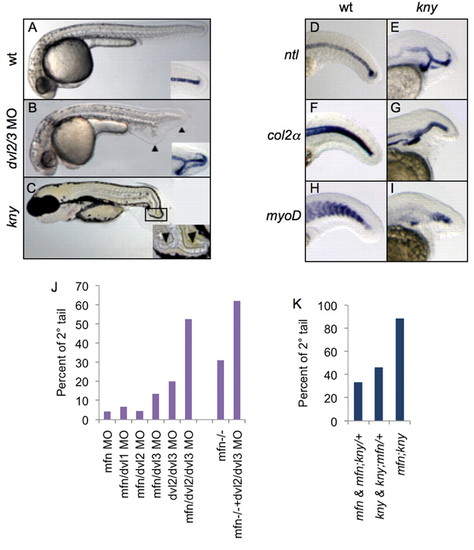Fig. 3
- ID
- ZDB-FIG-110622-87
- Publication
- Yang et al., 2011 - BMP and non-canonical Wnt signaling are required for inhibition of secondary tail formation in zebrafish
- Other Figures
- All Figure Page
- Back to All Figure Page
|
Non-canonical Wnt signaling functions with BMP to inhibit secondary tail formation. (A-C) Lateral view of wild-type (A, 24 hpf), dvl2/3 morphant (B, 24 hpf) and kny mutant (C, 72 hpf) zebrafish. Insets of A and B show ntl expression in the posterior tail. Inset of C shows a close-up of posterior tail. Primary and secondary tails are marked with arrowheads. (D-I) Lateral view of expression of ntl (D,E), col2a (col2α F,G) and myoD (H,I) in the tail of wild-type and kny embryos fixed at 24 hpf. ntl (E), col2a (G), and myoD (I) exhibit ectopic expression within the tails of kny. (J) Percentages of secondary tail formation in embryos injected with indicated combination of morpholinos (MO; 1 mg/ml each, except for ‘dvl2/dvl3 MO’ condition, where a concentration of 3 mg/ml for each MO was injected). For each column over 100 embryos from three separate experiments were scored. (K) Percentages of secondary tail formation in embryos from incross of mfn/+;kny/+ double mutant carriers. Embryos are categorized by phenotypes. Secondary tails in J and K were scored by ntl expression. |
| Genes: | |
|---|---|
| Fish: | |
| Anatomical Terms: | |
| Stage: | Prim-5 |

